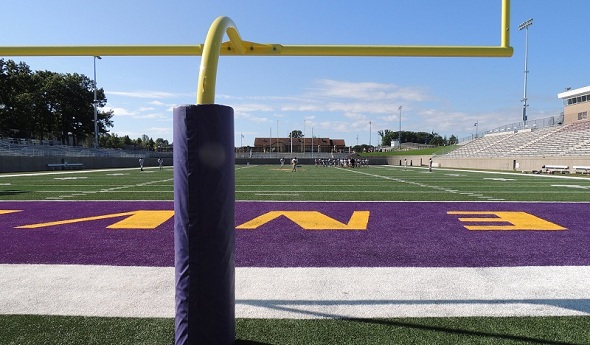
A Legacy Begins in Greenville
August 24, 2012
By Geoff Kimmerly
Second Half editor
GREENVILLE – Curtis Heppe has no idea what to expect, but a few guesses and a dream or two of how it will feel tonight to lead his teammates into Greenville's Legacy Field for the first time.
“It’s going to be electric, for sure. It’s a new vibe. It’s high-tech there,” the Yellow Jackets quarterback said Thursday after his team’s final preseason practice.
Those expectations are shared by a community that will be cheering on the local team in a new home after nearly a century at the legendary Black Field.
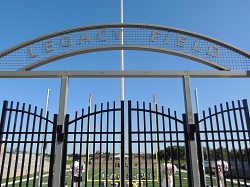 Workers put the finishing touches on the near-$7 million facility this week in advance of the season's first varsity game, tonight against rival Belding. Legacy Field officially opened for Wednesday’s freshman game, and Heppe said that even for that lower-level appetizer, the stadium began to come alive.
Workers put the finishing touches on the near-$7 million facility this week in advance of the season's first varsity game, tonight against rival Belding. Legacy Field officially opened for Wednesday’s freshman game, and Heppe said that even for that lower-level appetizer, the stadium began to come alive.
“We’ve just wanted Friday night to come. To get in and see how intense, how nice this place is,” he said. “Coming out of that tunnel, seeing our fans, it’s going to be the best feeling.”
Tonight’s grand opening will be the culmination of efforts from not just administrators, but students and community members as well – down to the name of the stadium itself.
“Legacy Field” was selected by Greenville’s school board. But it came as a suggestion from the school’s student council, which took submissions from classmates and then with faculty and administrators whittled the list to three favorites – Stinger Stadium and Community Field were next on their list.
But that’s just one way Legacy Field is a blend of old and new and ideas from all over town.
“In development, (it’s been) probably 10 years. We’ve been talking about it ever since I’ve been here, that one day we’d be able to do this,” said Greenville athletic director Brian Zdanowski, who is entering his 15th school year at that post. “It came through strategic planning. It came through community input. And then ultimately, our board bought in that there was enough interest in the community.”
Deeply rooted
A walk through Legacy Field is a history lesson. But first, an explanation of the Yellow Jackets’ past.
Black Field had served as the team’s home since 1916. It is nestled downtown next to Greenville’s former high school, which is now a library.
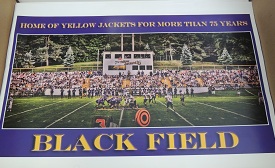 The current high school, about 1.5 miles northwest, was built in 1963. Football teams continued to make the short trip for home games.
The current high school, about 1.5 miles northwest, was built in 1963. Football teams continued to make the short trip for home games.
Black Field has its charms. With no track surrounding the field like at many multi-purpose stadiums, fans are only a few yards from the sideline. And all of that history added to the mystique for the latest players to wear the uniform.
The field also has had peculiarities. Zdanowski said at one point, the end zones were elevated in the corners. And the field wasn’t always square – a 10-yard penalty might measure 11 on one side of the field but only nine yards on the other.
But after just about every home game, students met for a bonfire on the grounds, an extension of the celebration by neighborhoods that surround Black Field and embraced the team for decades.
“It was the typical focal point of the community,” Zdanowski said.
Some things old, many new
Playing on Black Field was special, Heppe added. But he's equally if not more excited to be part of this new legacy. And architects made sure to bring that community feel to the new home this fall.
Destruction and construction began May 2, the day after last season’s final girls tennis match. The courts formerly sat in what is near the south end zone, and were moved closer to the track and soccer facility.
Amenities at the Yellow Jackets’ new football home are comparable to a college stadium’s, starting at the north side of the field.
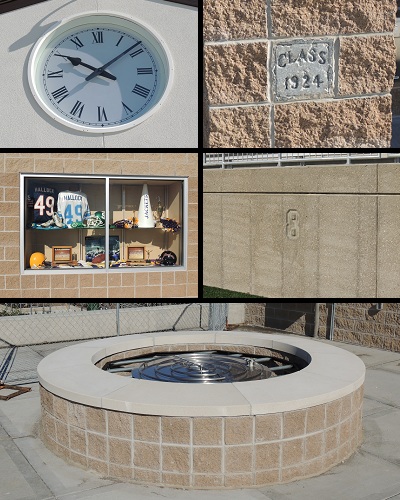 Players will enterthrough a tunnel that pours into the field like that of a miniature Spartan Stadium. Surrounding the tunnel are expansive locker rooms both for the home team and visitors, a similarly expansive training room and officials area and plenty of storage that will allow Greenville’s entire football program to be housed under that one roof. Unlike Black Field, tucked neatly among its neighbors, Legacy Field has plenty of parking and lighting, and builders were able to make that possible while also keeping intact a group of large oak trees near the south gate.
Players will enterthrough a tunnel that pours into the field like that of a miniature Spartan Stadium. Surrounding the tunnel are expansive locker rooms both for the home team and visitors, a similarly expansive training room and officials area and plenty of storage that will allow Greenville’s entire football program to be housed under that one roof. Unlike Black Field, tucked neatly among its neighbors, Legacy Field has plenty of parking and lighting, and builders were able to make that possible while also keeping intact a group of large oak trees near the south gate.
The turf is synthetic, like that played on by all but one member of the Yellow Jacket’s O-K Bronze conference. The difference from many is that the field has been dug out from the surrounding property, making it even more a focal point for those who will occupy the roughly 4,000 seats in the surrounding cement bowl. (The removed dirt was used to build two Little League fields on another part of the property.)
The sound system is of course state-of-the-art, and the press box, concessions area and restrooms also are equally expansive. But what locals should notice most are the throwbacks to the past that dot every corner of their new home.
Cut into the brick work near the concession counter is a block from Black Field that had been dedicated by the school’s class of 1924. Atop the building is the Centennial Clock, 100 years old this year, which formerly hung at the entrance the old school and was donated by the class of 1912. It has been housed by Greenville’s museum until being re-donated to the school district to become part of the stadium.
Molded into the cement walls on the west and south sides of the field are the numbers formerly worn by players Henry Loding and Greg Blumberg. Both died from football-related injuries; Loding in 1906 and Blumberg in 1977. Two trophy cases are cut into the stone on the facing of the press box, including one featuring mementos celebrating alum and former Detroit Lions tight end Ty Hallock.
Another addition of historical significance will come later. The school’s first Hall of Fame class will be inducted before the Sept. 7 game, and that display will be housed near the south ticket area so residents and fans can check it out without having the enter the stadium itself.
And one last thing was added to keep with tradition. To the west of the concession area, but within the stadium fence, sits a large gas fire pit for those postgame gatherings – plus a sound system where students can plug in their mp3 players.
“We said we’re not forgetting our past, but we’re embracing our future,” Zdanowski said. “I’m sure a lot of people have said that before. So we really wanted to make sure we got community input on it and do as much as we could to replicate Black Field. … And I think we won some people over. We really wanted to do what we said (we’d do).”
PHOTOS: (Top) Greenville's junior varsity ran through drills during a morning session at Legacy Stadium, which opened this week. (Top middle) The ticket area and gate for fans sit on the south side of the field. (Middle) A poster given out last season celebrated the final to be played at Black Field. (Bottom middle) A number of pieces of Black Field's past and Greenville tradition were brought over to or included in Legacy Field, including Centennial Clock, which formerly was part of the old school.
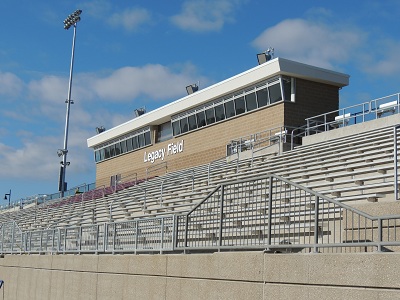
Legacy Field's press box is split into areas for game workers, coaches and media with a roll-up door for film crews.
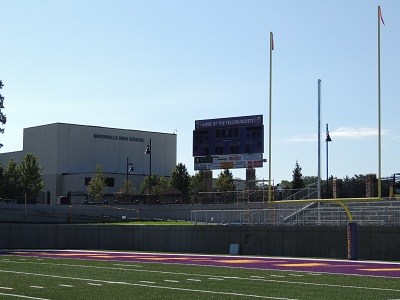
Legacy Field sits between Greenville's high school and middle school and adjacent to its soccer and track facilities.
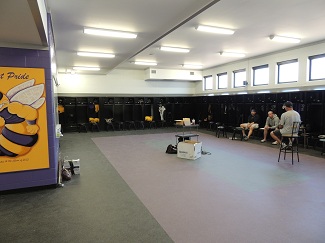
Coaches met in the spacious varsity locker room Monday morning. Junior varsity and freshman locker rooms are connected by a hallway with access to storage areas and the coaches' office.
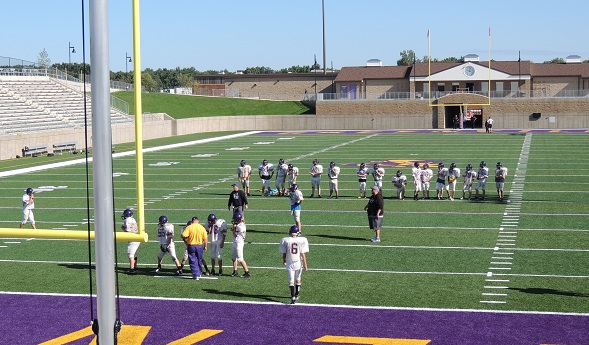 Players will enter Legacy Field through a tunnel at its north end. Above sits the concession area and restrooms, and the Centennial Clock that once ticked in the old Greenville school.
Players will enter Legacy Field through a tunnel at its north end. Above sits the concession area and restrooms, and the Centennial Clock that once ticked in the old Greenville school.
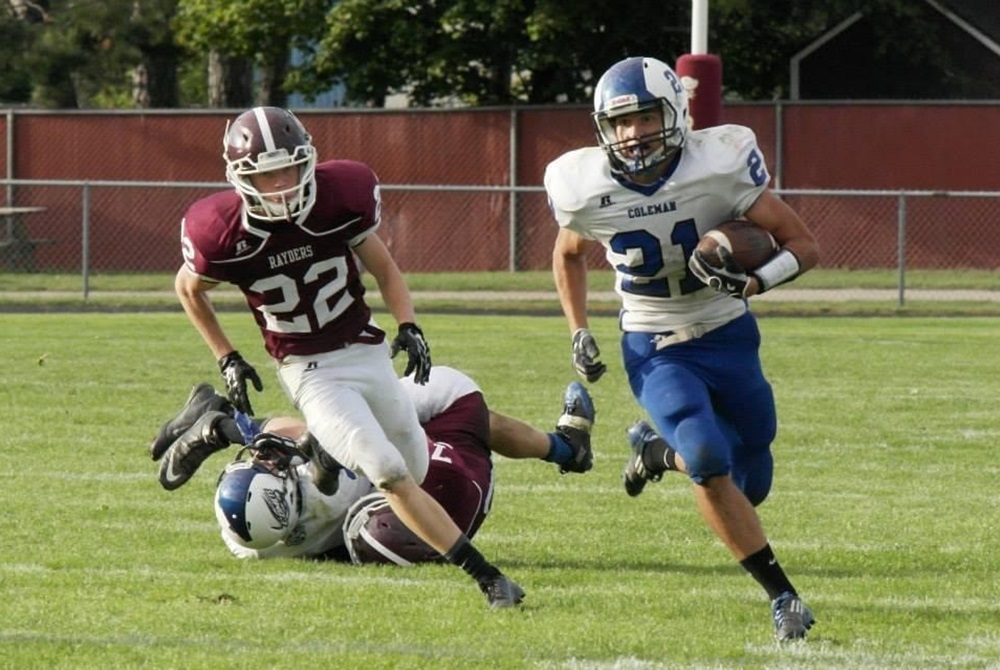
In the Long Run: Only 15 Rushers Share State Record with 99-Yard Scoring Sprint
By
Steve Vedder
Special for MHSAA.com
August 26, 2024
Jakob Price remembers the defense forcing him into a subtle change of plans at the line of scrimmage, then about a dozen seconds later finishing his run into the MHSAA record book.
It's a rare story that only 15 football players in MHSAA history can tell, most involving similar circumstances. A couple of key blocks, the opening of but a sliver of a hole, a fortuitous breakdown on defense including a broken tackle or two, capped, in many cases, by simple luck.
When it comes to a rusher busting loose on a 99-yard run, there is much that has to fall into place. In the case of Price, a sophomore at Muskegon when he became the last player to make that rare record-tying dash on Oct. 8, 2021, it was all the above.
"I remember we ran what we called a "power 6" and I hit the line hard," Price said. "I saw that the hole off the center was clogged, and I thought I was going to get hit, but I made a move. Three guys had a shot at me, but someone took out the tackle with a block and I saw nothing but green. It was almost a safety, but then this hole opened up and I was gone."
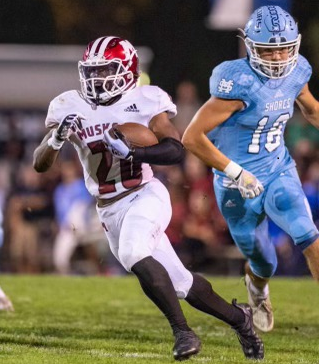 In comparison, for instance, there have been 81 players who've thrown for at least six touchdowns in a game. But only 15 players in Michigan history have snatched a handoff and sped 99 yards to pay dirt. It's a wide cast of characters that stretches from one player who has played in 12 major league baseball games to another who collected three times as many receiving yards as rushing and whose previous longest run had been a modest 25.
In comparison, for instance, there have been 81 players who've thrown for at least six touchdowns in a game. But only 15 players in Michigan history have snatched a handoff and sped 99 yards to pay dirt. It's a wide cast of characters that stretches from one player who has played in 12 major league baseball games to another who collected three times as many receiving yards as rushing and whose previous longest run had been a modest 25.
The first 99-yard run chronicled in the MHSAA record book was by James Edington of Morrice, who raced 99 yards against Kingston on Oct. 29, 1999. Edington's run was one of his last during an outstanding four-year career that included being named all-state three times. He remembers the play, which came late in a playoff game, being an inside trap where he broke at least two tackles. Edington said the play wasn't designed for anything more than to keep the defense from notching a safety.
"I was just trying to get out of the end zone, get us some room," said Edington, who remembers having 4.7 speed in the 40-yard dash. "I remember it was at the end of the game and I was so tired. I was a two-way player who rarely came off the field. I know that in a 99-yard run the blocks have got to be there when the defense hits the box. I knew if I could just get past this linebacker, there was a lot of green grass in front of me."
Morrice, coincidentally, also is the only program to have a 99-yard runner in 8-player football. Morrice switched from 11 to 8-player with the start of the 2014 season, and Jake Rivers made the 99-yard sprint twice in 2015.
Saugatuck coach Bill Dunn is the only coach to have two players on the list, including his son Blake, on Sept. 25, 2015, against Decatur.
From a coaching standpoint, Bill Dunn said there is nothing like a crushing 99-yard burst to change a game's momentum. When a team is clinging to the ball at its 1-yard line, the possible outcomes are seemingly dark – from surrendering a safety to a punt that puts the opposition in prime position to score.
"A lot of things have to happen in a 99-yard run," Dunn said. "There can absolutely be luck. And it can be a backbreaker. You got a team at the 1-yard line, and the defense knows it's going to get good field position with a punt. But instead you get a guy who breaks one for 99."
 Blake Dunn, now a prospect in the Cincinnati Reds system, was an all-state sprinter in high school as part of earning 16 varsity letters across four sports. Dunn said he made a "mid-line read" after the fullback dove into the line. The defense collapsed on him, Dunn cut back against the grain and was off to the races.
Blake Dunn, now a prospect in the Cincinnati Reds system, was an all-state sprinter in high school as part of earning 16 varsity letters across four sports. Dunn said he made a "mid-line read" after the fullback dove into the line. The defense collapsed on him, Dunn cut back against the grain and was off to the races.
"Our fullback dove down the mid-line, and my read crashed down to him," said Dunn, whose 101 career touchdowns are fourth in state history while his 6,954 rushing yards rank eighth.
"When I followed my blocks through the hole, there was a bunch of open grass. I think there might have been a linebacker that almost tripped me up from the backside, but nobody was able to get me and then 99 yards later it ended in a touchdown. It was pretty cool fun in the moment and fun to look back on it now."
Kyle Raycraft of Frankenmuth made his 99-yard run against Caro on Sept. 5, 2003. Like many of his brethren’s stories, Raycraft, who remembers running for more than 200 yards and three or four touchdowns in the game, said the play came down to a couple of blocks, shaking off potential tacklers, and having daylight in front of him.
"I went up the middle and got good blocking at the line and broke a couple tackles," said Raycraft, also an all-state sprinter and currently an emergency room doctor in Sault Ste. Marie. "I really didn't think that much of it at the time. I think it got us the lead at a key time and that was exciting, but I didn't think it was so rare. There's been a lot of high school football and only (15) kids have done this, so that's a pretty short list."
Matthew Hoffman of Sanford Meridian, by his own admission, wasn't particularly fast. So speed played a minimal part in his run Sept. 11, 2015, against Beaverton.
Hoffman ran track in the spring, but not as a sprinter; he ran distances. His piece of football history was more a result of getting a couple of key blocks, breaking through the line, making a cut and finding running room along the sideline.
"I broke to the line and swerved to the left to the sidelines," said Hoffman, now a certified rescue boat operator working on the Gordie Howe International Bridge for the Bridging North America company. "I was quick and shifty and I'd get a few breakaways, but I wasn't fast. I think the defense was looking for me on the right side, and it was a counterplay to the left. The offensive line did a great job on that play.
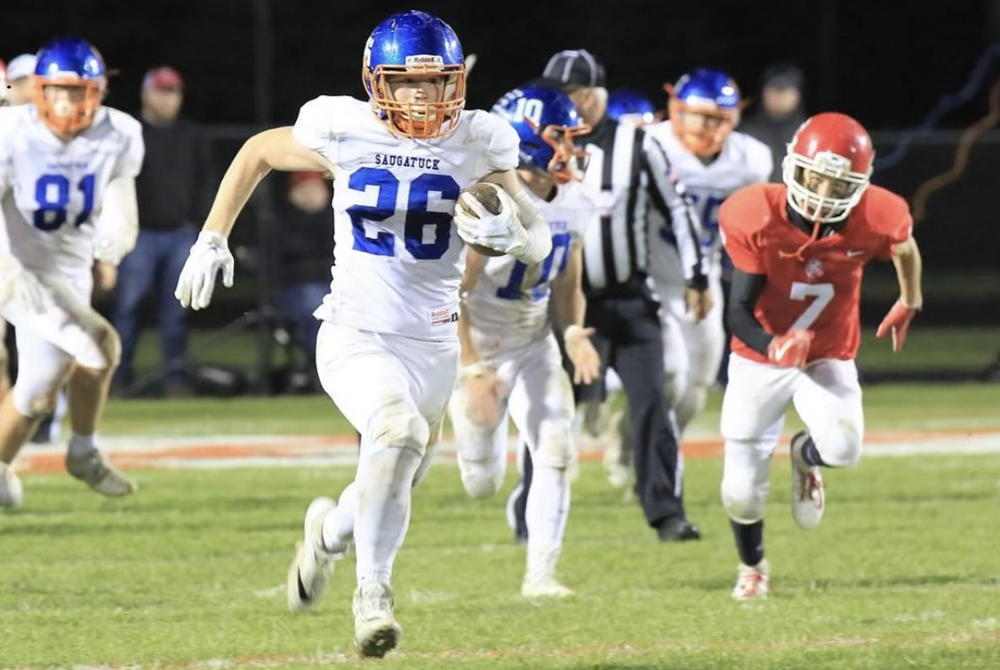 "It was exciting, but (instead of records) it was more it just happened so quickly. People met me in the end zone after the play was over, but then we were just focused on defense and the next play."
"It was exciting, but (instead of records) it was more it just happened so quickly. People met me in the end zone after the play was over, but then we were just focused on defense and the next play."
Coleman's Mitch Franklin has another different slant on his 99-yard story. He was primarily a receiver who recorded 1,014 yards at that position as opposed to around 300 as a running back. But on Sept. 13, 2014, against Charlevoix, Franklin took advantage of a rare handoff after a quarterback sneak had netted virtually no gain on first down.
"Best blocking we had all year. A hole opened up, I stiff-armed a guy and just ran," said Franklin, a former Gladwin County sheriff’s deputy. "I remember I was fortunate to run on our right side where we had bigger guys. It was fortunate that we caught the defense off guard. I think it was about our first power run that game and a lot of fortunate things had to happen.
"One of the things I remember is our principal patting me on the back and telling me what a good run it was."
While the members of the select 99-Yard Club may have different memories as to how they successfully dashed from their team's 1-yard line into the other team's end zone, their goals were the same: Just somehow move their team from the shadow of their own goalposts into more favorable territory.
And one last goal, recalled Franklin.
"Hey, you just don't want to make that long drive home with a big, fat ‘L,’” he said. "You want to win the game. That's what was important."
The MHSAA is continuously adding to its record books, and there is no deadline for an accomplishment to be submitted. Find directions to do so and the football record books in full at this link.
PHOTOS (Top) Coleman's Mitch Franklin (right) turns upfield during a 99-yard scoring run against Charlevoix on Sept. 13, 2014. (Middle) Muskegon's Jakob Price (left) makes a move on the way to a 99-yard touchdown run against Muskegon Mona Shores in 2021. (Below) Saugatuck's Nick Stanberry breaks away for a 99-yard TD run against Kent City in 2018. (Photos provided by Franklin, Price and the Saugatuck football program.)

